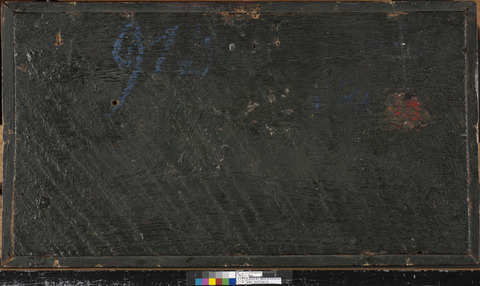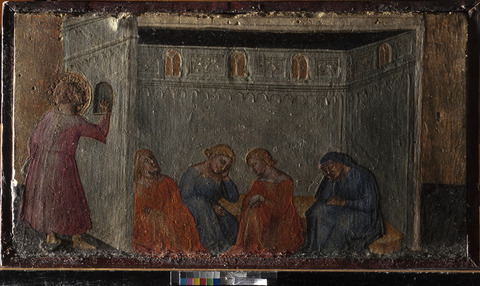Overview
Accession number: 2010.41
Artist: Bicci di Lorenzo
Title: Scene from the Legend of St. Nicholas
Materials: Egg tempera [confirmed] and gilding on poplar panel
Date of creation: About 1400–1410
Previous number/accession number: C10057
Dimensions:
18.5 × 34.5 cm (original)
20.4 × 36.5 cm (with edge strips)
Conservator/examiner: Roxane Sperber, Gregory D. Smith, Erin Rose Birdsall
Examination completed: 2020
Distinguishing Marks
Front:
None
Back:
Item 1. Blue paint inscription, handwritten “916” (tech. fig. 1).
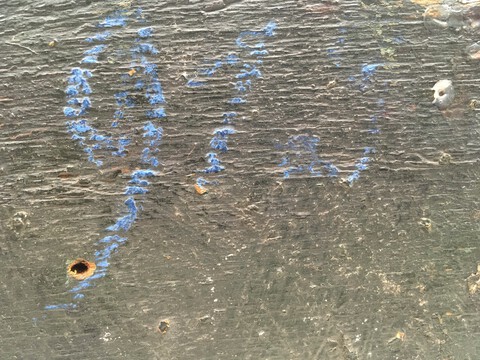
Item 2. Remnants of a red seal (see tech. fig. 32)
Summary of Treatment History
The painting has been significantly altered from its original construction as part of the predella of a larger altarpiece. The predella was, at some stage, cut down into vignettes that were presumably sold as individual paintings. Physical evidence on the painting suggests it has been treated numerous times prior to arrival at the IMA on long-term loan in 1971. These interventions included partial overpainting of the ceiling of the house as well as retouching across the painting.
Documentation suggests a series of condition assessments and treatments were carried out on the collection about the time the works were moved from the Clowes residence to the IMA in 1971. A condition report by Paul Spheeris in October of that year, likely carried out before the paintings were relocated, described the painting as “O.K.” He recommended that no treatment was necessary.1
A second condition assessment was carried out upon arrival of the paintings at the IMA. This assessment described the work as being in good condition, and no treatment was deemed necessary. An X-radiograph of the painting was made at this time.2
The condition of the painting was assessed by David Miller prior to formal accessioning by the IMA in April 2010. It was also documented in the Clowes Collection annual survey from 2011 to 2020.
Current Condition Summary
The painting is in generally acceptable condition. The panel is structurally stable, and for a painting of this age, the paint layer is in good condition. The paint has not suffered much abrasion, and losses are small and localized. The gilding, however, has been largely scraped and abraded leaving a disrupted surface. Perhaps due to abrasion of the original paint, the ceiling of the building has been overpainted with a modern pigment that is out of keeping with the rest of the painting. The painting would benefit from an aesthetic treatment.
Methods of Examination, Imaging, and Analysis
| Examination/Imaging | Analysis (no sample required) | Analysis (sample required) |
|---|---|---|
| Unaided eye | Dendrochronology | Microchemical analysis |
| Optical microscopy | Wood identification | Fiber ID |
| Incident light | Microchemical analysis | Cross-section sampling |
| Raking light | Thread count analysis | Dispersed pigment sample |
| Reflected/specular light | X-ray fluorescence spectroscopy (XRF) | Fourier-transform infrared spectroscopy (FTIR) |
| Transmitted light | Macro X-ray fluorescence scanning (MA-XRF) | Raman microspectroscopy |
| Ultraviolet-induced visible fluorescence (UV) | ||
| Infrared reflectography (IRR) | Gas chromatography–mass spectrometry (GC-MS) | |
| Infrared transmittography (IRT) | Scanning electron microscope -energy dispersive X-ray spectroscopy (SEM-EDS) | |
| Infrared luminescence | Other: | |
| X-radiography |
Technical Examination
Description of Support
Analyzed Observed
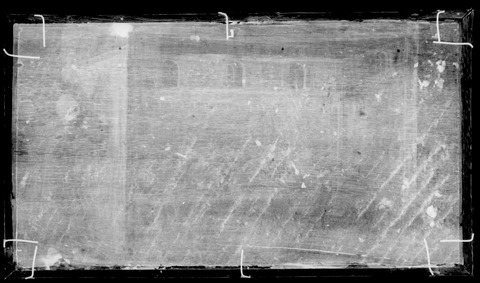
Material Type (fabric, wood, metal, dendrochronology results, fiber ID information, etc.):
The support is a single plank of wood with horizontally oriented grain (tech. fig. 2). The wood was identified by dendrochronologist Ian Tyers as Salicaceae, willow/poplar type.3
Characteristics of Construction/Fabrication (cusping, beveled edges of panels, seams or joins, battens):
The panel was likely part of a larger predella depicting the Legend of Saint Nicholas that was cut apart and sold as individual paintings. Prominent saw marks on the back (tech. fig. 3) are present and may be evidence of the original maker’s saw. It is also possible that the panel was thinned when the predella was cut apart.
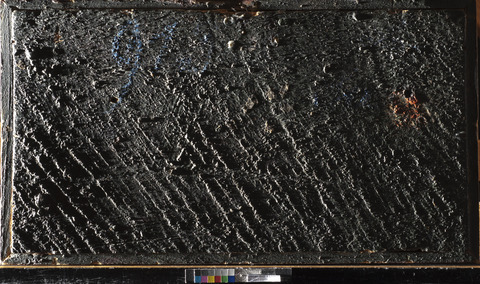
Although not visible in the X-radiograph, a layer of canvas is present on the panel. Several fibers of the canvas can be seen along the right edge of the panel when viewed using microscopy. This is typical of a panel preparation in medieval Italian painting.
Thickness (for panels or boards):
2.2 cm
Production/Dealer’s marks:
None
Auxiliary Support:
Original Not original Not able to discern None
Four strips of wood have been nailed to the edges of the painting, creating a border around the image.
Condition of Support
The support is in generally good condition. The panel is relatively flat and does not seem to be constrained by the wooden edge strips. On the back, a small crack along the bottom-left side of the support is visible. This crack has not split the wood through to the front of the support. This damage appears old and is currently stable. The back has been painted with black paint.
Description of Ground
Analyzed Observed
Materials/Binding Medium:
SEM-EDS analysis of the ground layer on cross section 1 from the area of grass (tech. fig. 4) shows a gesso ground composed of calcium sulfate (tech. figs. 5, 6) with several particles of dolomite (CaMg(CO3)2) (tech. fig. 7).
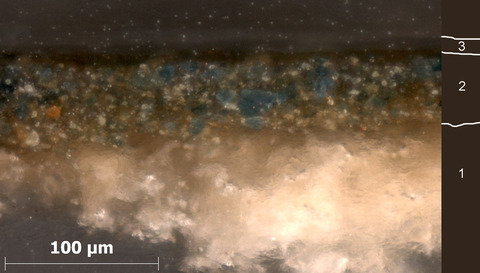
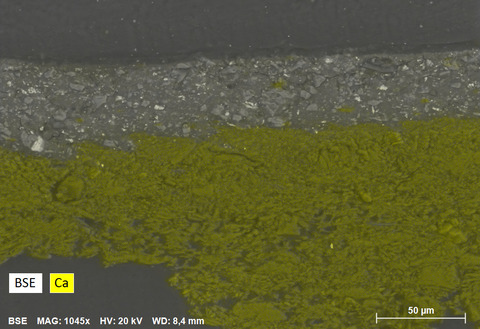
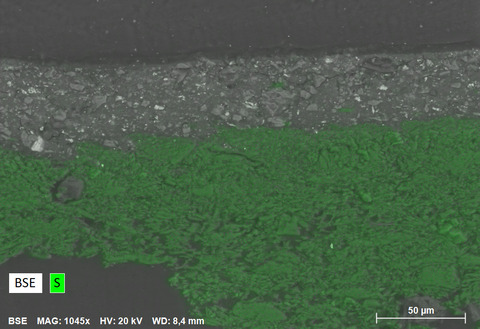
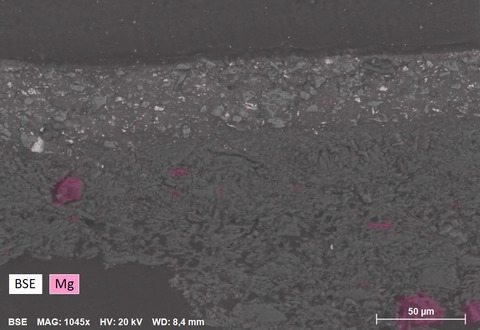
Color:
The ground is white (tech. fig. 4).
Application:
Cross section samples suggest the ground was applied in a single layer. This is not typical of fourteenth-century Italian painting, where a two-layer application of gesso grosso followed by gesso sottile was typically employed.4 It is possible that the cross-section samples did not sample the entire ground structure.
Thickness:
The ground is moderately thick. In the cross section the ground measures approximately 100 µm.
Sizing:
Cross-section samples do not show a sizing layer; however, it is likely that a size layer was applied when the canvas layer was applied to the panel.
Character and Appearance (Does texture of support remain detectable/prominent?):
The surface of the panel is smooth, and the canvas and ground layers appear to have obscured the texture of the wood panel.
Condition of Ground
The ground is in excellent condition. Aside from some small scattered losses across the paint layer and the bottom edge, the ground appears to be intact and stable.
Description of Composition Planning
Methods of Analysis:
Surface observation (unaided or with magnification)
Infrared reflectography (IRR)
X-radiography
Analysis Parameters:
| X-Ray equipment | GE Inspection Technologies Type: ERESCO 200MFR 3.1, Tube S/N: MIR 201E 58-2812, EN 12543: 1.0mm, Filter: 0.8mm Be + 2mm Al |
|---|---|
| KV: | 25 |
| mA: | 3 |
| Exposure time (s) | 180 |
| Distance from X-ray tube: | 36″ |
| IRR equipment and wavelength | Opus Instruments Osiris A1 infrared camera with InGaAs array detector operating at a wavelength of 0.9-1.7µm. |

Medium/Technique:
Although underdrawing in a dry medium cannot be identified using IRR, an infrared absorbent underpaint is clearly visible (tech. fig. 8). This layer appears to have been painted in a washy medium with a larger brush than was used in the final painting. The underpaint appears to have established the composition of the figures and building, leaving the figures in reserve. Although it is difficult to differentiate the final outlining, which is also carried out in an infrared absorbent material, the underpainting also appears to have devoted some attention to the faces and hair of the figures as some areas of the hair that are visible in the IRR are no longer visible in the final painted version. This work was done using a smaller brush in the same brown underpaint that can be partially viewed using microscopy. The perspective of the building was also addressed during this phase. The slightly skewed angle of the right wall is not quite right, and the window on that wall clearly gave the artist some difficulty, as there are changes visible in the IRR.
Description of Paint
Analyzed Observed
Application and Technique:
Before the paint application, water gilding was applied to the background of the panel. After the composition of the figures in a washy medium (see Description of Composition Planning), incision lines were made to delineate the edge of the water gilding from the paint layer (tech. fig. 9).
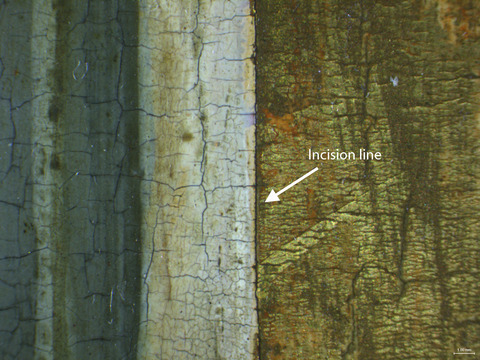
An incision line can also be identified on the right edge of the panel (tech. fig. 10). This mark may have demarcated the edge of an engaged frame or differentiated this scene from the next. It is also possible that this mark was used to guide the saw that cut the predella panels apart when the altarpiece was dismantled. Similar lines along the border of the top edge of the St. Benedict and St. Bernard of Clairvaux panels by Agnolo Gaddi were also observed.
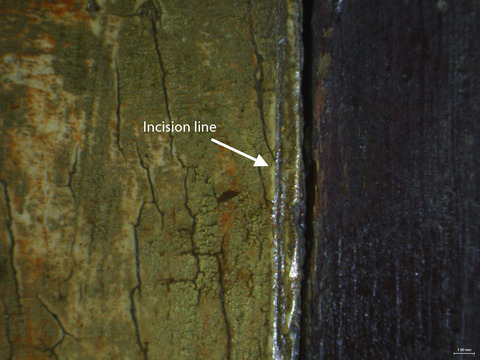
An orange bole layer was then applied to the areas that were to be gilded. This included the windows in the building. The adhesive in the bole would then have been activated with guilder’s liquor (a mixture of alcohol and water), and the gold leaf would have been applied. Once dry, the gold leaf would have been burnished and the design of St. Nicholas’s halo established with compass line and decorated with punches. Two punches were used in the halo of St. Nicholas, a circle punch with an empty center and a small dot punch that may have even been the point of the compass or another pointed implement (tech. fig. 11).
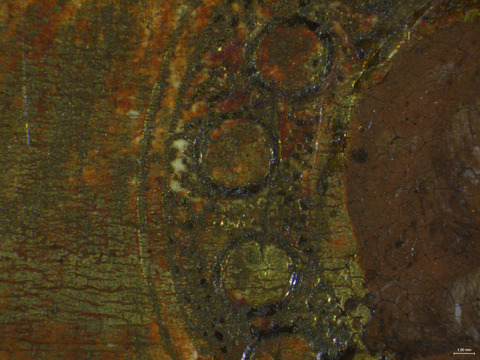
Paint layer
After the application of water gilding, the paint layer was applied beginning with the ground plane and architectural elements. The building and bench were painted, leaving rough reserves for the figures.
The faces and hair were painted before the robes. The figures' faces are painted with confident, gestural brushstrokes. Despite being very small, the features are individualized, each taking on a different expression (tech. figs. 12–15). A washy brown underpaint appears to have been used to block in areas of shadow in the skin. Notably, no green verdaccio layer is present, even in the skin of the young women. A mixture of lead white, vermilion, and iron oxide earth pigments was applied in small brushstrokes to build up volume in the skin. The application of the skin paint was thin in some areas of shadow, allowing the brown underpaint to show through the upper layers. This created the effect of shadow, much as a traditional verdaccio layer would. In other areas of shadow, however, brown paint was applied over the skin tone to reinforce the shadows. Bright strokes of white were used to create highlights on the figures' noses, chins, and brows. Outlining in both white and a dark yellow were used to create waves in the hair.
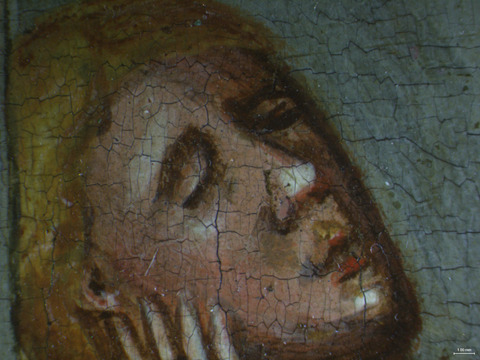
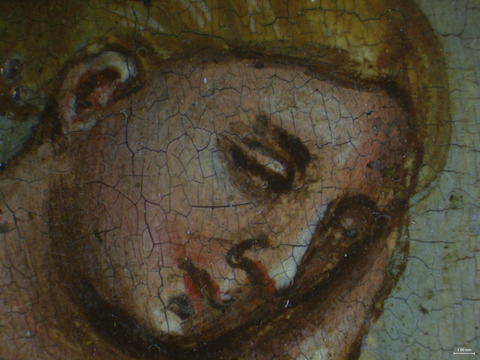
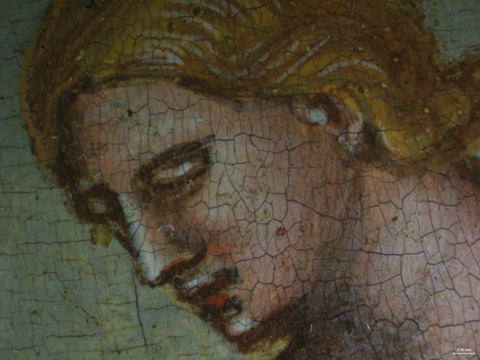
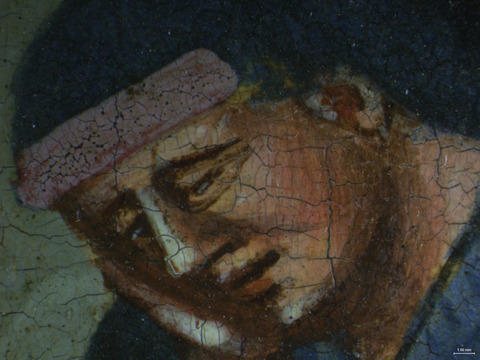
The robes were painted after the faces, leaving a rough reserve for the hands. The drapery on the figures in blue, as well as St. Nicholas’s robe in deep red, follows the drapery technique described by Cennino Cennini.5 The pure color of the robes, identified as ultramarine blue, was used for the darkest shadows. In the midtones the pure ultramarine was mixed with some white, and the highlights were a mixture with an even higher concentration of white (tech. fig. 16).
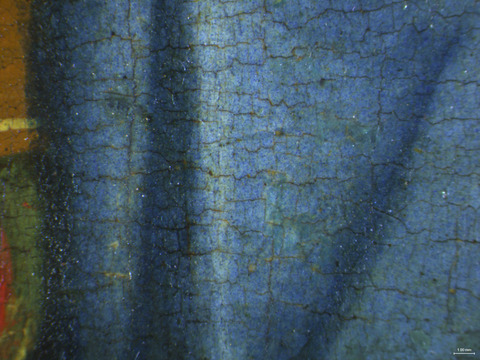
In the case of the red robes, composed primarily of vermilion, the technique is the same, but rather than mixing the red with white, it is mixed with lead-tin yellow (tech. fig. 17).
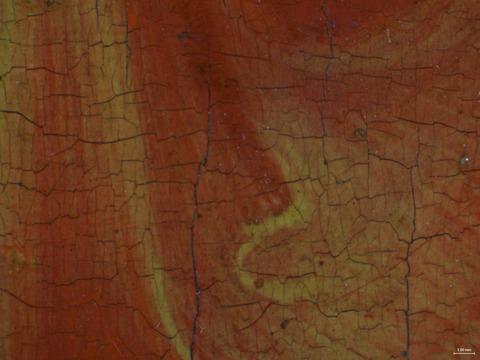
The hands were painted last and followed by delicate strokes of brown paint that were used to outline the features (eye lids, pupils, profiles), the neckline of the robes, and hands. In the boots of St. Nicholas, outlining with a dark yellow (composed of yellow ocher) was used around the bright yellow boot, painted using lead-tin yellow type II.6
Detailing was also added to the architectural elements, such as the stone arches and reliefs depicting acanthus leaf designs (tech. fig. 18). In these areas, brushstrokes of white create highlights and dark brown and black are used to mimic shadow. This efficient technique created the effect of elaborate architectural elements with relatively few brushstrokes.
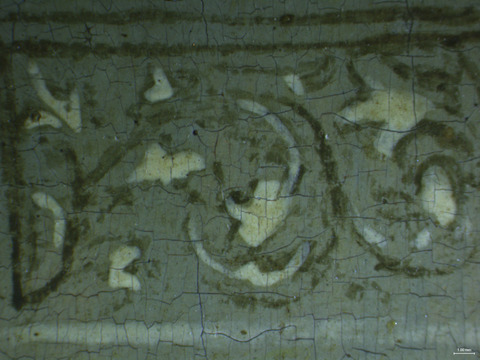
The coin in the hand of St. Nicholas was originally gilded with mordant gilding, and remnants of gold are visible. There is no bole present in this area, confirming the area was gilded using mordant, not water, gilding (tech. fig. 19).
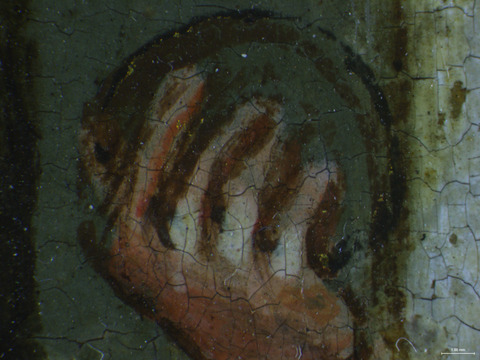
Painting Tools:
Small brushes were used for the minute details in the paint layer. A medium-sized brush was used to apply the washy underpaint. Gilding materials such as burnishing tools and punches were also used.
Binding Media:
The binding media was analyzed using FTIR and was found to contain oil and protein consistent with egg. This suggests the painting was created using the egg tempera technique.
Color Palette:
The color palette is wide ranging for a small panel and includes shades of green, blue, yellow, red, gray, brown, black, and white. XRF analysis combined with Raman microspectroscopy and SEM-EDS analysis were used to identify the range of pigments used by the artist. A calcium sulfate ground layer was applied across the panel (see Description of Ground). Lead was found in all locations, suggesting the widespread use of lead white.
Mercury was detected in the robe of the first daughter, suggesting the presence of vermilion in the bright red robes. No vermilion was present on St. Nicholas’s robe, however, which was likely painted using a red lake pigment (although this could not be confirmed using XRF).
The presence of lead-tin yellow type II was confirmed in the book of St. Nicholas. Lead and tin were also detected in the yellow highlight on the red robe of the first daughter, suggesting lead-tin yellow was mixed with vermilion to create the folds in the robe. Lead and tin were also detected in the bright yellow boot of St. Nicholas, suggesting the use of lead-tin yellow in this area as well, although a strong peak for iron was detected in the dark yellow outline, suggesting yellow ocher was used in this area. Similar pigment combinations were likely used in the bench, although this area was not analyzed.
Raman analysis confirmed ultramarine in the blue robe of the father, and a cross section from this area shows the large blue particles in layer 2. Although copper was detected in the blue robes using XRF, the cross section from the robe did not reveal the presence of a layered structure with ultramarine applied over a layer of azurite. Rather, a single layer of ultramarine appears to have been applied (tech. fig. 20, layer 2). The highlights in the blue robes were not analyzed but visual observation suggests the pure blue pigments were mixed with different proportions of lead white to create form.
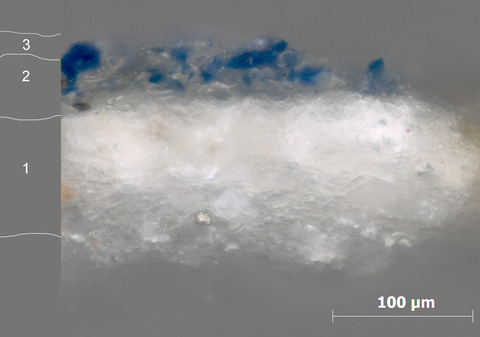
Cross section 1 (tech. fig 21), from the area of grass, reveals a paint layer composed of a rich mixture of iron-oxide earth pigments, aluminosilicates, lead white, and copper-containing blue-green pigments (tech. figs. 22–24).

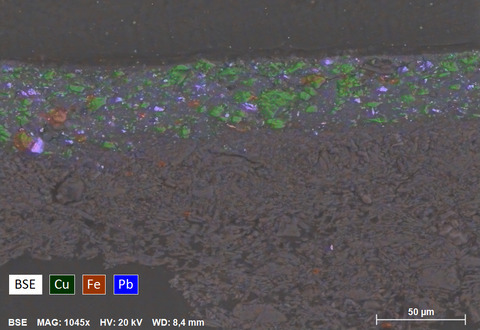
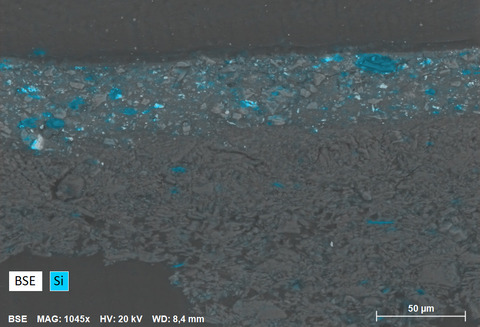
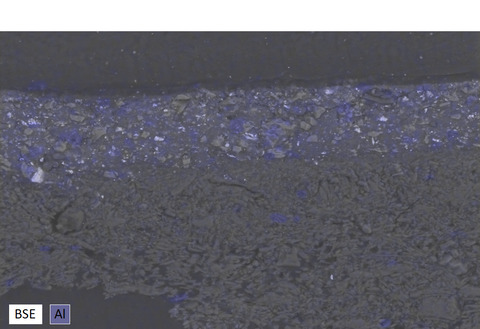
The gray of the building was analyzed, and lead was the primary element detected. This area was likely painted using a combination of lead white and a carbon-containing black pigment that could not be confirmed using XRF. The jet-black ceiling of the building is rather out of keeping with the rest of the color palette, and so it was analyzed using XRF. This area gave a very strong peak for iron as well as some zinc. Under the microscope, the layer is continuous across the ceiling, rather than exhibiting the localized retouching found across the rest of the painting. This suggests this area was overpainted using Mars black mixed with zinc white.
XRF analysis of the water gilding detected significant peaks for gold, copper, and zinc, suggesting the use of a metal alloy rather than a pure gold leaf. A cross section from this area (tech. fig. 26), however, shows an original gilding layer composed of pure gold covered with a layer of regilding that is composed of a copper-gold alloy (see Condition of Paint and Gilding).
XRF Analysis:
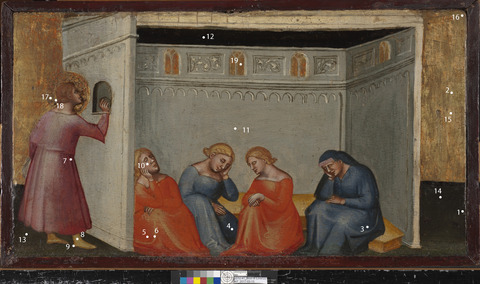
| Sample | Location | Elements | Possible Pigments |
|---|---|---|---|
| 1 | Exposed ground near green grass layer | Major: Ca Minor: Sr Trace: Fe, Cu, Pb | Calcium-containing ground layer, trace of lead white (possibly from green layer), copper-containing green and/or blue pigment (from green layer), trace of iron oxide (earth pigments from green layer). |
| 2 | Gilding | Major: Cu, Au Minor: Zn, Ca, Sr, Pb Trace: Fe | Copper/gold/zinc alloy leaf, iron oxide-containing bole layer, lead white, calcium (from ground layer). |
| 3 | Blue robe of father | Major: Pb Minor: Cu, Ca, Sr Trace: Fe, Si, K | Lead white, copper-containing blue pigment (azurite), trace of silicon (possible ultramarine), trace of iron oxide (earth pigments), calcium (from ground layer). |
| 4 | Blue robe of daughter 2 | Major: Pb Minor: Cu, Ca, Sr Trace: Fe, Si, K | Lead white, copper-containing blue pigment (azurite), trace of silicon (possible ultramarine), trace of iron oxide (earth pigments), calcium (from ground layer). |
| 5 | Red dress of daughter 1 | Major: Hg, Pb Minor: Sr Trace: Cu, Fe | Vermilion, lead white, calcium (from ground layer), trace of iron oxide (earth pigments), trace of copper-containing green and/or blue pigment. |
| 6 | Yellow highlight dress of daughter 1 | Major: Pb, Hg Minor: Sn, Ca, Sr Trace: Cu, Fe | Vermilion, lead-tin yellow, lead white, calcium (from ground layer), trace of iron oxide (earth pigments), trace of copper-containing green and/or blue pigment. |
| 7 | Robe shadow St. Nicholas | Major: Pb Minor: Fe, Ca, Sr Trace: Cu, K | Lead white, red lake (not confirmed using XRF) calcium (from ground layer), iron oxide (earth pigments), trace of copper-containing green and/or blue pigment. |
| 8 | Boot of St. Nicholas | Major: Pb, Hg Minor: Trace: Sn, Ca, Cu, Fe | Lead white, small amount of lead-tin yellow type II (confirmed with Raman microspectroscopy), calcium (from ground layer), trace of iron oxide (earth pigments), trace of copper-containing green and/or blue pigment. |
| 9 | Outline boot of St. Nicholas | Major: Fe, Pb Minor: Trace: Sn, Ca, Cu | Lead white, iron oxide (earth pigments), calcium (from ground layer), trace of copper-containing green and/or blue pigment. |
| 10 | Skin | Major: Pb Minor: Hg Trace: Fe, Ca, Cu | Lead white, vermilion, trace of copper-containing green and/or blue pigment, trace of iron oxide (earth pigments), trace of calcium (from ground layer). |
| 11 | Gray house | Major: Pb Minor: Trace: Fe, Ca, Cu | Lead white, trace of copper-containing green and/or blue pigment, trace of iron oxide (earth pigments), trace of calcium (from ground layer), carbon black (not identifiable using XRF). |
| 12 | Black ceiling | Major: Fe, Ca Minor: Pb Trace: Cu, Zn, Mn, K | Mars black, calcium (from ground layer), trace of copper-containing green and/or blue pigment, trace of zinc white, trace of calcium (from ground layer). |
| 13 | Green grass (left side) | Major: Cu, Pb Minor: Trace: Fe, Ca, Sr, Sn | Copper-containing green and/or blue pigment, trace of calcium (from ground layer), trace of lead-tin yellow. |
| 14 | Green grass (right side) | Major: Cu, Pb Minor: Trace: Fe, Ca, Sr, Sn | Copper-containing green and/or blue pigment, trace of calcium (from ground layer), trace of lead-tin yellow. |
| 15 | Gilding right side | Major: Ca, Cu, Au Minor: Fe, Zn, Sr Trace: Pb | Copper/gold/zinc alloy leaf, calcium (from ground layer), iron oxide-containing bole layer, trace of lead white. |
| 16 | Gilding upper-right corner | Major: Cu, Au Minor: Zn, Ca, Sr, Fe Trace: | Copper/gold/zinc alloy leaf, iron oxide-containing bole layer, calcium (from ground layer). |
| 17 | Gilding in halo | Major: Au Minor: Fe Ca, Sr Trace: Cu | Gold/copper alloy leaf, iron oxide-containing bole layer, calcium (from ground layer). |
| 18 | Gilding in halo | Major: Au Minor: Fe Ca, Sr Trace: Cu, Pb | Gold/copper alloy leaf, iron oxide-containing bole layer, calcium (from ground layer), trace of lead white. |
| 19 | Gilding in window | Major: Cu, Au Minor: Zn, Ca, Sr, Fe Trace: Pb | Copper/gold/zinc alloy leaf, iron oxide-containing bole layer, calcium (from ground layer), trace of lead white. |
Table 1: Results of X-ray fluorescence analysis conducted with a Bruker Artax microfocus XRF with rhodium tube, silicon-drift detector, and polycapillary focusing lens (~100μm spot).
*Major, minor, trace quantities are based on XRF signal strength not quantitative analysis
Surface Appearance:
The surface is smooth without any evidence of impasto and minimal texture from the age craquelure.
Condition of Paint and Gilding
The paint is in generally good condition for a work of this age. There are localized losses that have been retouched, but the faces and robes of the seated figures are almost entirely intact. The face of St. Nicholas has suffered some loss and has been poorly reintegrated. It appears that the ceiling of the building may have been overpainted, as its jet-black color is out of keeping with the rest of the painting. A thick black line along the top of the ground plane is also out of keeping with the technique of the rest of the painting. A small strip of the composition at the bottom edge has suffered extensive damage and has been largely reconstructed.
The most severe damage to the painting is the abrasion of the gilding. The mordant gilding has been almost completely abraded, as can be seen in technical figure 19, which shows the coin in St. Nicholas’s hand that was once gold with mordant gilding. The water gilding has also been severely abraded. XRF analysis detected copper throughout the areas of gilding (table 1, samples 2, 15–19), but a significantly smaller peak for copper was detected in the area of the halo where the original gilding appeared intact (table 1, samples 17, 18). This discrepancy prompted further investigation of whether the original gilding was a copper-gold alloy or whether the presence of copper related to a regilding campaign.
Cross section 3 (tech. fig. 26) shows the original gilding (layer 3) on the left side of the cross section. This gilding is extremely thin and is applied over an iron-rich bole (layer 2) (tech. fig. 27). The gilding is composed of pure gold (tech. fig. 28) with no copper component. The regilding (layer 4) is visible on the right side of the cross section and is thicker than the original gold leaf. The regilding contains some gold, but also contains copper (tech. fig. 29). The widespread presence of copper in the gilded areas of the panel suggested the panel was largely regilded.
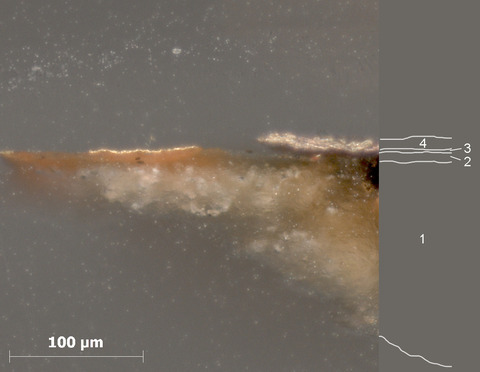
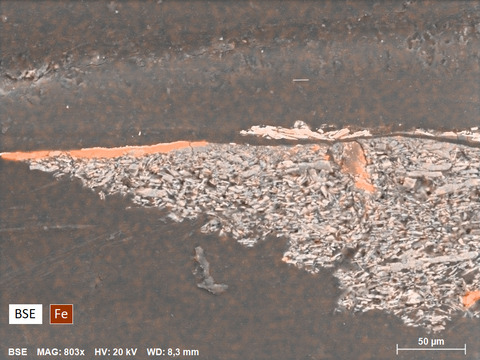
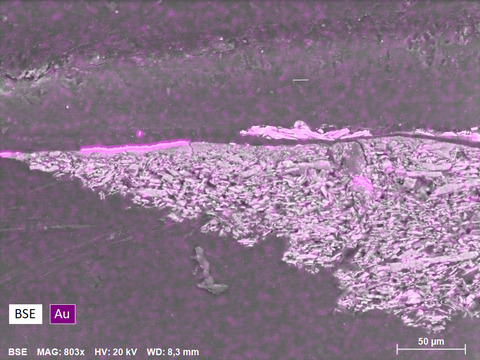
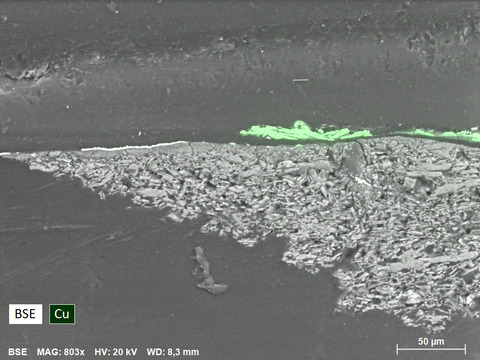
Description of Varnish/Surface Coating
Analyzed Observed Documented
| Type of Varnish | Application |
|---|---|
| Natural resin | Spray applied |
| Synthetic resin/other | Brush applied |
| Multiple Layers observed | Undetermined |
| No coating detected |
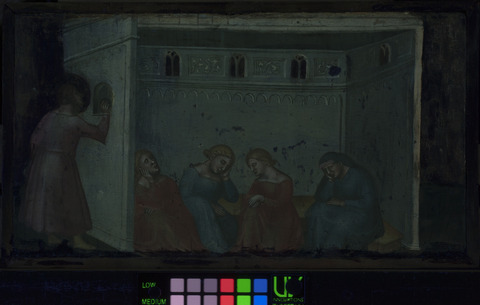
The surface coating does not fluoresce strongly (tech. fig. 30), nor has it severely discolored. There may be a thin layer of natural resin varnish followed by a coating of synthetic varnish. Further analysis would be necessary to determine this layer structure with certainty.
There is considerable retouching present on the painting. Aside from the overpainting in the ceiling of the building, though, it is restricted to areas of loss.
Condition of Varnish/Surface Coating
The varnish coating is in satisfactory condition. The colors are well saturated, and the coating is relatively even. The retouching is slightly discolored, and some of it, such as in the face of St. Nicholas, is hastily applied, taking away from the crisply painted original. The painting would benefit from conservation treatment to address these issues and reintegrate the paint layer in a way that more favorably addressed the composition.
Description of Frame
Original/first frame
Period frame
Authenticity cannot be determined at this time/ further art historical research necessary
Reproduction frame (fabricated in the style of)
Replica frame (copy of an existing period frame)
Modern frame
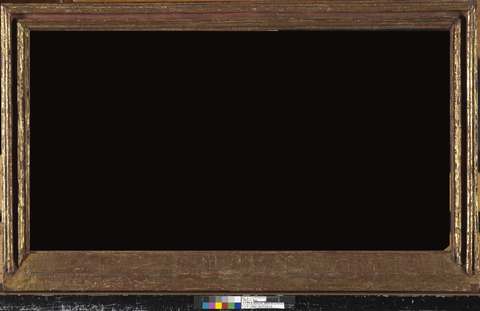
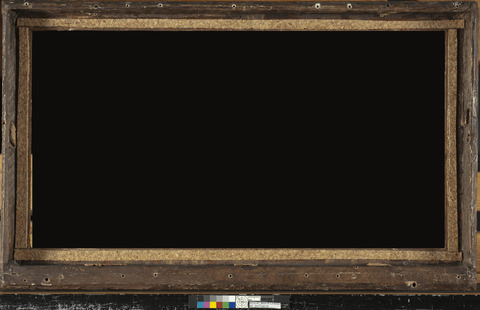
Frame Dimensions:
Outside frame dimensions: 32.4 × 47.6 cm
Distinguishing Marks:
None
Description of Molding/Profile:
The frame is a simple cassetta-style frame made of carved wood. The lower edge of the frame has a slanted molding, while the other three edges have moldings composed of two decorative beads on the outer edge with one on the inner edge and a flat area in the middle (tech. fig. 31). Water gilding covers the lower edge and the beads along the top and sides, while the flat central portion has exposed red bole. The back of the frame has several screw holes where a metal plate fits to the back to secure the painting in place (tech. fig. 32).
Condition of Frame
The frame is in good condition.
Notes
-
Paul A.J. Spheeris, “Conservation Report on the Condition of the Clowes Collection,” 25 October 1971, Conservation Department Files, Indianapolis Museum of Art at Newfields. ↩︎
-
Martin Radecki, Clowes Collection condition assessment, undated (after October 1971), Conservation Department Files, Indianapolis Museum of Art at Newfields. ↩︎
-
Ian Tyers, “Tree-Ring Analysis and Wood Identification of Paintings from the Indianapolis Museum of Art: Dendrochronological Consultancy Report 1082,” January 2019, p. 32, Conservation Department Files, Indianapolis Museum of Art at Newfields. ↩︎
-
Cennino Cennini, The Craftsman’s Handbook (Il libro dell’arte), trans. Daniel V. Thompson (New Haven: Yale University Press, 1936), 70–73. ↩︎
-
Cennino Cennini, The Craftsman’s Handbook (Il libro dell’arte), trans. Daniel V. Thompson (New Haven: Yale University Press, 1936), 92–93. ↩︎
-
Lead-tin yellow type II was confirmed in this area using Raman microspectroscopy. ↩︎
Additional Images

